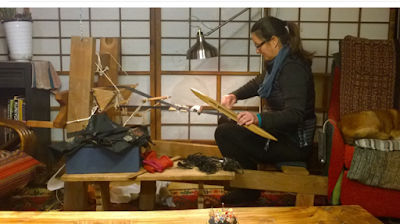My birthday and the anniversary of immigrating to Japan fall in early Aquarius. 28 full years in my adopted country. It was a anniversary trip.
Wistful hairline....wistful cold wind through my sweater.
Kofu is only a few hours away. It is the peach and grape growing area of Japan. Famous for warlord Samurai, thick wheat noodles, greedy pork barrel politicians and lacquered leather.
Last spring at Morita textiles, Mrs Morita excitedly showed me a newly acquired pair of deer skin trousers from the late 1800's. The beguiling story of the trousers....they were refashioned from deerskin samurai jacket from the Edo period. The obvious wear of the jacket collar was now visible on the bum of the trousers. Wow.....


The trousers looked like they had a orange striped lining but in more careful examination it was actually the suede side of the leather that was patterned.


She explained that the pattern had been smoked onto the leather with paper resisting the stripes. She continued on that is an extinct technique.
Gone.
My imagination ran wild.
The next mystery was how the green colour was created. There are no natural true green dyes in nature. It is always a combination of a yellow and indigo. How can you dye only one side of the skin?
Always playing with the idea of a small indigo museum on the second floor of the clay storehouse next to the house the trousers were procured. (They actually fit.)
They have sat on an open shelf and admired frequently.
I figured out that they had actually come from Kofu a few weeks back and on a clear day a few of us took the train out to Kofu to see what vestiges of the tradition of smoking deer leather we could find.
Turned out to be a gimmicky sort of display in the corner of a gift shop selling lacquered "inden"
leather products. But we all got excited like kids and decided on the spot to rig up a smoker, find a small mountain of rice straw, fix up a barrel to rotate over the smoke, find some deer skin.....and make some smoke patterned leather and paint on indigo on the opposite side.....just for fun.
We are getting all the materials together and as soon as it warms up a little we do it.

These techniques are regional secrets....we asked as many questions as the shop keeper was willing to answer.

And some stealth photographs of the tools hanging around were shared later over a beer as we plotted to overthrow the local industrialists of the neighbouring fife.

The smoker oven with a roof tile door.

Tied and smoked and tied again and smoked some more....so ingenious.
The small museum was just so satisfying. What is the word for the uplifting feeling when you see beautiful old masterfully crafted textiles?
The small museum had indigo dyed deer leather items. Katazome dyed indigo deer leather. Laquer stencilled leather and smoke dyed leather goods.
Jackets. Gloves for archery. Purses. Tobacco pouches. Leather armour scraps. Shoes. Drum bags. Hats. Horse saddles.
So beautiful... all this pre-industrial Japanese hand work.









These are deer leather stencilled patches from samurai armour.


Fine stitching on archery gloves.




Regular Ise katagami stencils are used for the resist process.

























